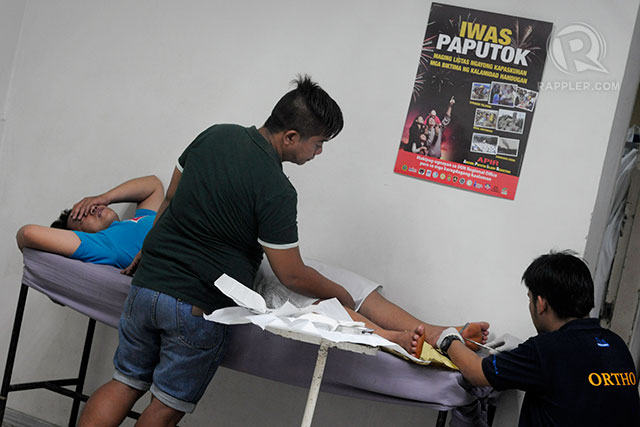SUMMARY
This is AI generated summarization, which may have errors. For context, always refer to the full article.

MANILA, Philippines (4th UPDATE) – Injuries from fireworks and firecrackers during the New Year revelry reached 599 as of 6 am of Wednesday, January 1.
In a press briefing Wednesday morning, officials of the Department of Health (DOH) said the number is 43% higher compared to the same period last year but the injuries were “milder.” The department gathered the data from 50 hospitals nationwide.
DOH Assistant Secretary Eric Tayag said the number is expected to rise leading to January 5 as the department gets more reports, and as Filipinos continue lighting fireworks and firecrackers despite strong warnings and the department’s information campaign.
Tweets from Tayag’s Twitter account, @erictayagsays, point to the following statistics as of 3:00 pm, January 1:
| Injury statistic | 2012 information | 2013 information |
| % of children under 10 with fireworks injuries | 31% | 24% |
| % of fireworks injuries among bystanders | 44% | 36% |
| % of Amputations from firworks injuries | 3% | 1% |
| % of Eye injuries from fireworks injuries | 19% | 14% |
| % of Piccolo-related fireworks injuries | 40% | 45% |
| Source: Official Twitter of Dr. Eric Tayag, 3pm, January 1 |
Tayag said it will be known on Thursday whether or not 2014 will surpass the 5-year average of more than 900 injuries.
“We announced a trend that we are seeing 50 to 80 injuries per hour nationwide. There are delayed reports so we expect those to come in and add to the number, and there are still people using firecrackers. Children usually pick those left on the streets, thinking these are used up but the firecrackers actually haven’t exploded yet. It’s likely these will explode on their hands,” Tayag said in Filipino.
“Our police, the DOH and parents cannot relax yet and be complacent because there are still children who may use firecrackers and meet accidents,” Tayag added.
as of 6:00 AM Jan 1 Total FW related injuries 599: FW injuries 589 FW ingestion 1 Stray bullet 9; piccolo 267/589 or 45% #APIR @DOHgovph
— Doc Eric Tayag (@erictayagSays) January 1, 2014
In 2012: FW related injuries 419: FW injuries 409 FW ingestion 1 Stray bullet 9 #APIR @DOHgovph
— Doc Eric Tayag (@erictayagSays) January 1, 2014DOH to call for firecrackers ban
The health officials said banned firecrackers – Piccolo, Five Star and the Pla-pla – remained the leading cause of the injuries.
DOH Undersecretary Janette Garin quoted Health Secretary Enrique Ona as saying that the department will campaign against the sale of firecrackers to individuals.
“Secretary Ona said that after the holidays, the DOH will spearhead the call for a total ban on firecrackers, especially selling to individual persons and promote community fireworks displays to avoid these types of accidents,” Garin said.
Garin said law enforcement by the national and local governments, and the involvement of the private sector is key.
Health Undersecretary Teodoro Herbosa described the injuries in 2014 as “milder.”
“I think laws regulating the amount of gunpowder that can be put into fireworks helped. Another factor is our campaign to tell children not to use firecrackers, and our call for people to immediately bring victims to the emergency room. There are more cases now but they are milder,” Herbosa said.
Baby killed by stray bullet
Among the victims of early celebrations on Tuesday included an 8-year-old boy in Cebu City who lost his right hand due to a powerful firecracker, and a 40-year-old woman in Manila with an accidental gun wound.
Philippine National Police Spokesman Senior Superintendent Wilben Mayor said there are 22 victims of stray bullets in 2014 so far, with one fatality, a 3-month-old baby in Ilocos Sur.
In 2013, two died after getting hit by stray bullets during the New Year revelry, triggering widespread public calls for stricter gun controls. Among those killed was 7-year-old Stephanie Nicole Ella.
This year, cops and soldiers were warned of demotions or dismissal from service if they were caught firing their guns as part of the revelry.
Injuries in Baguio
In Baguio City, the DOH recorded injuries despite the city’s ban on firecrackers. The department said there were 12 reported firecracker-related injuries in the city, compared to just 6 cases last year.
Baguio Mayor Mauricio Domogan banned the sale of firecrackers in the city for the first time but some residents decided to buy in Manila or in the border of Tuba, Benguet, where the sale was permitted a few days ago.
There were fewer fireworks displays even if the sale was permitted. The New Year morning was also clear of smog for the first time in decades.
The DOH said that there were fewer firecracker-related injuries in the Cordillera Administration Region, 27 compared to 34 injuries in 2013.
Baguio had the highest number of injuries, followed by Benguet. There were no injuries reported in Apayao and Kalinga.
Victims were aged two to 46. The cases included amputation of a finger, facial injuries (two), eye injuries (two), and blasts and burn without amputation (23).
The firecrackers used were Piccolo (16), Pla-pla (2), kwitis (4), improvised (2) and other types (3). – Rappler.com
Add a comment
How does this make you feel?
There are no comments yet. Add your comment to start the conversation.